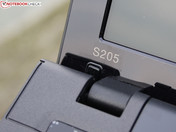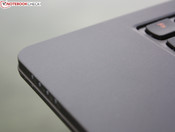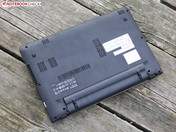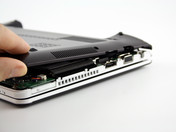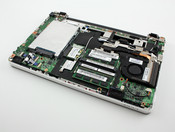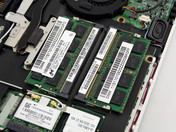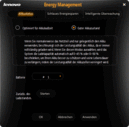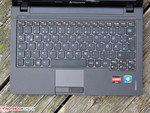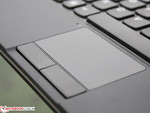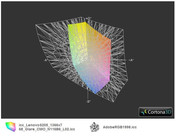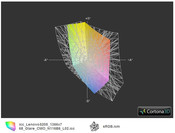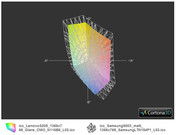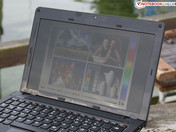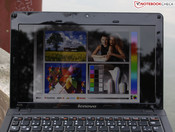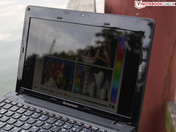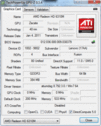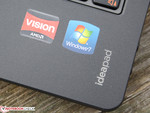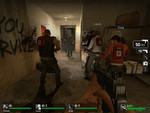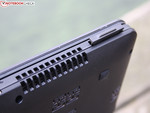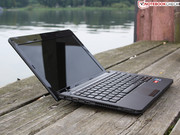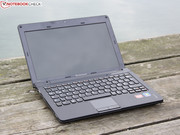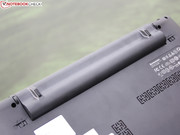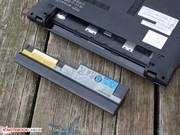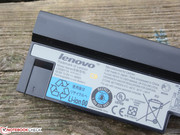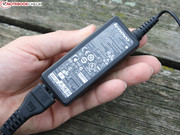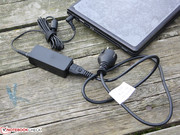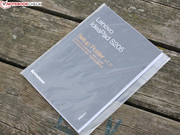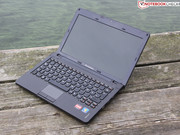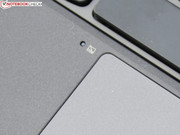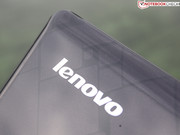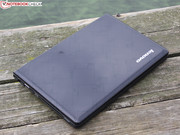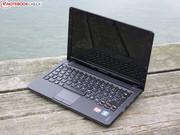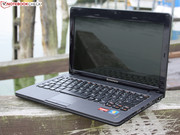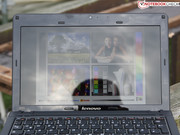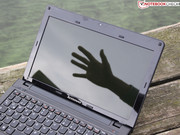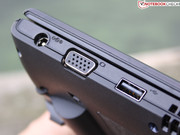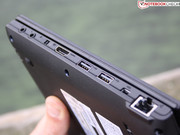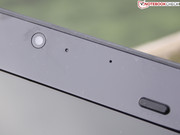Review Lenovo IdeaPad S205 (Fusion) Subnotebook

Lenovo occupies one of the top places with its IdeaPad S205 (M632HGE) in the scramble of the best subnotebooks. At least, when we look at the FreeDOS version with a small 250 GB hard disk and 1024 RAM (M632GGE). This bundle goes over the counter for 260 euros. That is almost netbook level and the cheapest AMD Fusion E-350, 11.6 incher currently on the market. It only gets cheaper with the weaker C-30 and C-50 APUs in the Asus Eee PCs, 1015BX (like 1015B).
Since we weren't in the mood for a typically exasperating Lenovo Windows drivers' installation, only the "deluxe" version, S205 (M632HGE), with 3072 MB of RAM, a 320 GB HDD and Windows 64bit came into question for us. Then it costs 370 euros. But: The rating difference between low-end and deluxe is small. Almost all specifications in this review also apply to the bargain IdeaPad S205 (M632GGE).
Case
The work surface consists of plastic with fine longitudinal grooves. This makes the wrist-rest is slip-proof and pleasant at the same time. The battle against fingerprints is won here. But not so on the TFT bezel and display surface because they are made of high-gloss plastic. The black lid with the cuboid pattern is a small eye-catcher, as well as very stable (deformation test). Light pressure applied to the lid's surface hardly forces it to yield.
The construction's stability looks good. The wrist-rest's surfaces, the area above the keys and the bottom fit tight and don't yield anywhere. We really liked the bottom's homogeneous surface. However, there are no covers for exchanging the hard disk or memory. Alike the equally constructed U160 (pictures 4-6), the base plate can be detached after removing a lot of screws.
The memory components and the hard disk can nevertheless be exchanged. There are instructions for this in the user's manual. The entire base plate can be lifted away after removing several screws, taking out the keyboard and removing more screws. The 2.5 inch HDD and two DDR3 RAM slots are underneath.
The hinges are pulled tight. Thus, the screen stays firmly in place in every position. The lid teeters a bit on shaky grounds (train or car traveling). The hinges have a good opening angle of almost 145 degrees. The hinges don't have a clear stop in the end position and allow the lid to teeter in the final position. The force that keeps the lid and base unit closed is fairly big thanks to two magnets in the wrist-rest (paperclip test) and the display bezel. But it's not enough. The lid opens two centimeters when held upside down.
Connectivity
The interface array is very small, but the most necessary ports are available. Besides three USB 2.0 ports, the device has both an analog (VGA) as well as a digital HDMI video out. Beyond that, the S205 doesn't differ from an Atom netbook (usually without HDMI). A cutting edge USB 3.0 port would have been welcome, but it's not possible in this price category. The IdeaPad S205 doesn't have a docking port in contrast to the ThinkPad range due to the consumer alignment.
Communication
The Fast Ethernet network card no longer complies with the current standard. Most buyers will be able to get over that in view of the price because the path that leads to the Internet is usually via WLAN. The Atheros wireless module is capable of WLAN standard 802.11 b/g/n (draft n). Bluetooth is also installed in all S205 versions (also FreeDOS M632GGE), even if it is the obsolete 2.0 standard.
Supplies
The black box hardly contains any supplies for the device. There is the adapter with power cable and a small set-up poster. The scope of software, besides the operating system Microsoft Windows 7 Home Premium (64 bit), is fairly small. System tools, such as Boot Optimizer (cleans up registry), One Key Recovery (recovery) and Power Management (e. g. limit the battery charge to 50%) seem to make sense. DirectShare (synchronizing among PCs/USB drives in the network) and VeriFace (face recognition) extend the user's possibilities.
Warranty
Lenovo grants a warranty period of 24 months, including a bring-in service, ex-factory. This however doesn't apply to the FreeDOS model that only is given 12 months. In case of damage, the product has to be sent to Lenovo. A maximum warranty of 36 months can be selected as an optional upgrade. The entry price for an extension is around 80 euros.
Input Devices
Keyboard
The keys have a slightly squashed layout, but a sufficient key size. This is particularly evident on the narrow, but still useable, enter key. The key surface fits tight and thus we have a firm (not hard) stroke. The accuracy is increased due to the key's conic cavity. Fingers don't slide around as fast to the left or right.
The pressure point is clear but the key drop is fairly short. This causes a somewhat wooden typing feel. However, this is basically a matter of accommodation. The S205's keys can't hold a candle to an Edge 11, but it is very close to the latter's very good feedback.
Touchpad
The touchpad has been inserted into the wrist-rest and gives the finger an agreeable resistance due to tiny knobs. A sensor for automatic deactivation is located beside the pad. When hands cover it while typing, the pad no longer accepts any inputs. This prevents incorrect entries. The mouse pad can be completely disabled via an FN key.
The mouse pad especially impresses with its quiet keys that have a clear key drop. There is no exact pressure point, but we don't miss it during fast clicking anyway. The multi-touchpad (Synaptics V7.2) detects the use of two fingers (two finger gestures). This allows us to zoom with two fingers, for example. There is a vertical scroll bar that is visibly marked. The horizontal would only be activated in the Synaptics control.
Display
The 11.6 inch (29.46 cm) screen has a resolution of 1366x768 pixels (HD Ready). This is a practical resolution for this size. In contrast to the typical netbook resolution of 1024x600, the overview on the desktop improves, which is the reason why many buyers choose 11.6 inches. HD Ready is also still the standard resolution of 14 and 15 inches.
According to the readout, it is the same screen model, CMO N115B6-L02, as in the IdeaPad U160 and in the Timeline X1830T (mid 2010). The CMO panel is not anti-reflective. That benefits the optical effects of colors, but it causes reflections depending on the light incidence. The wheat is separated from the chaff when it comes to the contrast of a screen. 178:1 speaks for inferior chaff. The majority of low-end netbooks, subnotebooks and notebooks have equally poor contrasts. Consequently, black colors aren't deep black. They have a light grayish tinge.
As expected, the screen can't reproduce the sRGB color spectrum. However, this point is insignificant for this low performance consumer subnotebook's purpose. Professional picture editing won't be done on the IdeaPad.
| |||||||||||||||||||||||||
Brightness Distribution: 86 %
Center on Battery: 153 cd/m²
Contrast: 178:1 (Black: 0.93 cd/m²)
40.67% AdobeRGB 1998 (Argyll 3D)
58.1% sRGB (Argyll 3D)
39.27% Display P3 (Argyll 3D)
The screen's brightness isn't suitable for use in the sun, but it is for the living room or student dig. The average of the entire surface is 165 cd/m2. The LED screen distributes its brightness evenly. An illumination of 86% stands for that. The brightness is reduced slightly to 153 cd/m2 (center) in battery mode. This can't be changed in the Windows settings, BIOS or Energy Manager.
The horizontal viewing angles are usable. We recognize color well up to about a 50 degree deviation from the center position. They first invert beyond that. However, the picture already starts to dim clearly at 25 degrees. It looks a lot worse when our view sways downward (vertically). Script can only be read well up to about 30 degrees. But colors start to falsify at 10 degrees. When several pairs of eyes gather in front of the S205, the viewers in the upper/lower rows will hardly recognize anything. That is a bad characteristic for a movie companion.
Performance
Lenovo equips the 11.6 incher with the dual core APU, AMD E-350 (2x1.6 GHz). This Accelerated Processing Unit (18 watts TDP) has an incorporated graphics unit with DirectX 11 and UVD3 video decoder for HD videos (MPEG-2, H.264, VC-1). With 80 shaders, the Radeon HD 6310 is more than a match for the Intel HD 3000 (12 shaders) or the GMA 3150 (2 shaders, Atom netbooks).
The APU E-350 only has an L2 cache of 1024 KBs. Both Bobcat cores are superior to the similarly clocked Atom N550 dual core with its out of order implementation. The core sits on the AMD A50M chipset and is accompanied by 3072 MB of DDR2 RAM. A possible upgrade to 4 GBs can be done for little money thanks to two RAM slots (about 25 euros).
Core i3 low voltage or Atom dual core subnotebook alternatives have the Hyper Threading advantage of four computing cores. The E-350 can only calculate simultaneously executed multitasking operations on two cores, but that "out of order". Advantage or disadvantage for multitasking operations? It's up to the multi core benchmark, Cinebench R10 32 bit, to enlighten us. The S205 achieves 1960 points. An Atom N550 reaches 1463 points. The N550 is thus slower by averagely 30%. An i3-380UM manages, despite a lower clock, 33553 points (Edge 11 Intel). The AMD Fusion APU C-50 (e. g. Edge E125) cannot keep up at all here. It has an average score of 1279 points.
The E-350 only accomplishes 1030 points in single core calculations in Cinebench R10 Single 32bit. So, despite 1.6 GHz, the APU is slower than a 380UM that reaches 1268 points with 1.33 GHz. The Atom N550 that only just reaches 512 points is again defeated. Just like the C-50 APU: ~655 points.
The synthetic CPU benchmarks only let the AMD E-350 look good opposite to Intel's Atom dual core. What will Windows users notice? We use PCMark Vantage and PCMark 7, which checks all components including DDR3 RAM, hard disk and graphics card. 2259 points, respectively 867 points are the tight, but nevertheless Fusion APU typical results.
Although the scores are higher than in netbooks with a C-50 (1647 / 766, Edge E125) or Atom N550 (1671 / -, Samsung NF310), they are clearly inferior to an i3-380UM (3619 / -, Edge 11) and i5-2410M (5778 / 1594 points, HP EliteBook 2560p). The Edge 11 with an AMD K345, so virtually the Fusion range's precursor, is slightly superior to the S205 with 2409 / 1003 points. 7 The PCMark scores haven't been ascertained for all test devices.
In short: According to the system benchmarks, the S205 is a lot slower (38%) than i3-380UM systems, but still measurably faster than Intel's Atom dual core. The somewhat longer copy or installation times are noticed subjectively. The Fusion is acceptably fast during simultaneous execution of several installations and copy processes. The experienced speed is therefore better than with an Intel Atom dual core.
HD Video with CPU Relief
The incorporated HD 6310 ensures CPU relief via the UVD3 Video Decoder (Avivo HD), e. g. in high definition 1080p videos. Mandatory is that the player uses this function when it plays H.264, VC-1, MPEG-2 and Adobe Flash. This is the case in Windows Media Player. The following screens show video load in battery and power supply operation. The 1080p clips still run smoothly when the CPU is put under 100% load with Prime95. The clip first stutters when the graphics benchmark, Furmark, is run at the same time.
| PCMark Vantage Result | 2259 points | |
| PCMark 7 Score | 867 points | |
Help | ||
Our test system achieves 1963 points in 3DMark2006. The Radeon HD 6310 is clearly below the typical results of an HD Graphics 3000, as incorporated in Intel Core CPUs. They reach scores of at least 3000 points (@ i3-2310M). Our Fusion S205 can assert itself among the HD netbooks, though. The AMD based Aspire One 521 (1046), Asus Eee PC 1015PN (1155), Asus Eee PC 1015B (C-50, 1411) and Aspire One 722 (C-50, 1460) are defeated in 3DMark 2006.
The latest 3DMark 11 (score P271) confirms this trend. The smaller Fusion graphics, HD 6250 (C-50), only manages P190. An entry level notebook graphics, such as the Geforce GT 520M, achieves ~P50. The HD 3000 can't be assessed due to the lack of DX11.
Cinebench R11.5's OpenGL test shows the HD 6310's pure shader performance. 7.4 points is an impressive result for an almost-netbook (11.6 inches). An HD 4225 only achieves 2.1 points (Edge 11). The in 2010 often used, smallest dedicated Nvidia GPU 310M managed 7.5 to 8.5 points. The HD 3000 manages 7.3 when accompanied by weaker Core CPUs and nearly 10 points with stronger processors.
| 3DMark 2001SE Standard | 8340 points | |
| 3DMark 03 Standard | 5673 points | |
| 3DMark 05 Standard | 3577 points | |
| 3DMark 06 Standard Score | 1963 points | |
| 3DMark 11 Performance | 271 points | |
Help | ||
The Hitachi hard disk (320 GBs, 5400 rpm) only manages below average data throughputs. PCMark Vantage's HDD score records 2787 points, which is a low rate even for 5400 rpm. HDTune (60 MB/s read) and CrystalDiskMark 3.0 (74 MB/s read) determine low rates in accordance.
Everyone who wants to effectively tackle slow accessing and thus ensure a subjectively faster system speed should upgrade to a 2.5 inch SSD. 150 to 700 MB/s are achieved with a flash memory in read (RAID 0 only). See e. g. Schenker XMG A701 Advanced. 60 GB SSDs are available for starting at just under 100 euros.
The HD 6310 isn't good for gaming, which we prove with random tests. The Bobcat CPU core slows down the graphics, as the following comparison shows. Hunting down Zombies (Left4Dead) is only fun in the lowest possible resolution of 640x480 pixels (low details). The frames are brought to their knees with 1024x768 in high details, and consequently the accuracy is affected (21 fps).
Modern Warfare from 2009 already occasionally stutters (explosions) in minimum details (800x600). Medium details can't even be considered. The same applies to StarCraft 2. The gaming fan can cross out Risen (20 fps) and Mafia 2 (12 fps) from the list - absolute deadlock.
Due to the weak CPU, the HD 6310 can't develop its full potential, which becomes evident in Left4Dead. An HD 4225 (Edge 13, Athlon K685) supplies the same frame rate of 34 fps (low). Just like in StarCraft 2, whereas an older HD 4250 also manages 44 fps. Both named ATI GPUs are actually weaker (40 rather than 80 pipelines). They were however accompanied by normal AMD Athlons/Turions in the test laptops. Even an incorporated HD Graphics 3000, but paired with a stronger 2410M processor (MSI CX640), reaches 23 fps in Mafia 2 (low) and not only 12 fps like the HD 6310.
| low | med. | high | ultra | |
|---|---|---|---|---|
| Crysis - GPU Benchmark (2007) | 25 | |||
| Crysis - CPU Benchmark (2007) | 29 | |||
| Left 4 Dead (2008) | 34.8 | 20.9 | ||
| Risen (2009) | 20.1 | 11.4 | ||
| CoD Modern Warfare 2 (2009) | 29 | 13 | ||
| StarCraft 2 (2010) | 44.9 | 11.9 | ||
| Mafia 2 (2010) | 12.3 |
Emissions
System Noise
The system noise shows itself positively. The 11.6 incher is mostly audible with 30-35 dB (A) (idle, office), but the level is acceptable, respectively low when HD videos are played (GPU load) and surfing on the Internet. The fan shuts down in idle. The hard disk is very quiet and is at most noticed with 30.7 dB (A) (read / write heads active). The cooling system can get quite loud in the stress test, but only then, with 38 dB (A). But the S205 only reaches a noise level of 35 dB (A) when only 3DMark 2006 is active.
Noise level
| Idle |
| 30.4 / 30.6 / 31.5 dB(A) |
| HDD |
| 30.7 dB(A) |
| Load |
| 34.8 / 37.8 dB(A) |
 | ||
30 dB silent 40 dB(A) audible 50 dB(A) loud |
||
min: | ||
(+) The maximum temperature on the upper side is 36.5 °C / 98 F, compared to the average of 35.9 °C / 97 F, ranging from 21.4 to 59 °C for the class Subnotebook.
(±) The bottom heats up to a maximum of 40.9 °C / 106 F, compared to the average of 39.3 °C / 103 F
(+) In idle usage, the average temperature for the upper side is 27.8 °C / 82 F, compared to the device average of 30.8 °C / 87 F.
(±) The palmrests and touchpad can get very hot to the touch with a maximum of 36.1 °C / 97 F.
(-) The average temperature of the palmrest area of similar devices was 28.2 °C / 82.8 F (-7.9 °C / -14.2 F).
Speakers
The tiny speakers underneath the wrist-rest aren't particularly loud, but at least they didn't scratch in higher volumes. The mid-ranges are drowned out, there are no low pitches and trebles aren't clear. Music fans would be advised to connect external loudspeakers via a 3.5 millimeter jack cable. We tested the analog out with two active Yamaha speakers (YST-M20SDP). We didn't hear any static in a simple audio test in a low output level.
Battery Life
Matching the good battery runtimes, we measure a low power consumption with and without load. 6.6 watts in idle comes close to the power consumption of netbooks and is on a par with the 2010 Timeline X 1830T (11.6 inches, 520UM, 6.5 watts). The recently reviewed ThinkPad Edge 11 (K345), an 11.6 incher with the quasi precursor range (Champlain) still consumed 14 - 16 watts in idle. This shows the AMD Fusion's leap in terms of reducing the idle power consumption. The S205's maximum idle power consumption is 10.4 watts, depending on the energy profile, brightness and wireless modules' activity.
The power consumption during load increases only moderately. 3DMark 2006 needs 20 watts, and the stress test, made up of Furmark and Prime95, is satisfied with 27 watts. The battery was fully charged during the tests. The 40 watt adapter is adequately designed for the power consumption.
| Off / Standby | |
| Idle | |
| Load |
|
Key:
min: | |
The S205 meets the expectations placed on a portable subnotebook in terms of battery life. The 11.6 incher manages exactly 3:30 hours (220 minutes) in WLAN surfing at a brightness of 100 cd/m2. The opposite is the case during constant CPU load, with the Battery Eater Classic here (high performance energy mode). This test drains the battery within the shortest time, but nevertheless equals 2:21 hours. The battery needs 3:27 hours when the PC is turned on, which is a disproportionally long charging time. 2:00 hours would be typical.
Verdict
Lenovo sets up an affordable consumer subnotebook called IdeaPad S205 (M632HGE / FreeDOS version starts at 260 euros). It can score in terms of battery life and workmanship. If you want to avoid Intel Atom (lower HD performance), but don't want to pay the higher price for an Intel Core Low Voltage (i3-380UM, i3-2357M), the S205 is a real alternative when looking around for a subnotebook.
However, the IdeaPad S205 11.6 inch's advantages go beyond the price. The slim case, shaped like a book, is only made of plastic but it is nice and stiff like its lid. Many subnotebooks (even expensive ones) can take a page from its book in regard to the input devices. The typing feedback is agreeable and the touchpad's movable keys allow fast and quiet clicking.
The always low power consumption of 6 to a maximum of 27 watts is the specialty of the AMD Fusion with the Zacate APU E-350. But the application performance clearly lags behind dual core Pentiums or smaller Intel Core CPUs. Nevertheless, Windows users need not fear a jerky work speed. Simultaneous execution of programs works faster than with an Intel Atom dual core. PCMark Vantage's score (2259) confirms the weak system performance, which however is superior to an Atom N550 system with Nvidia's Ion (e. g. Asus Eee PC 1015PN: 1823 points).
If slower booting times and lame copying processes can be redeemed by the AMD Radeon HD 6310 graphics depends on the used programs. Provided they use the graphics card processing performance, such as Windows Media Player, it can be said to have an absolutely good performance. Coded 1080p videos (H.264) still run smoothly even when the CPU is put under 100% load (battery mode also).
The low power hunger ensures battery runtimes of 3:30 hours in practical use (WLAN surfing, occasional video). Although that isn't as much as an Atom dual core netbook can offer, the user gets an HDMI out in return.
A quiet fan in normal use (31.5-35 dB (A) is in line with the low power consumption. The slim case can heat up to 41 degrees during high load, which is still acceptable. The contrast weak screen with the poor brightness is the S205's saddest chapter. Reflections and a dark desktop deter diligent outdoor use completely.
The FreeDOS version, with a 250 GB hard disk and a 1024 MB RAM, is available for starting at 260 euros (M632GGE). If you want an Intel Core in any case, you will have to pay a lot more. At least 450 euros are due for a Lenovo ThinkPad X121e in the FreeDOS version (Core i3-2357M, 1.30GHz).




